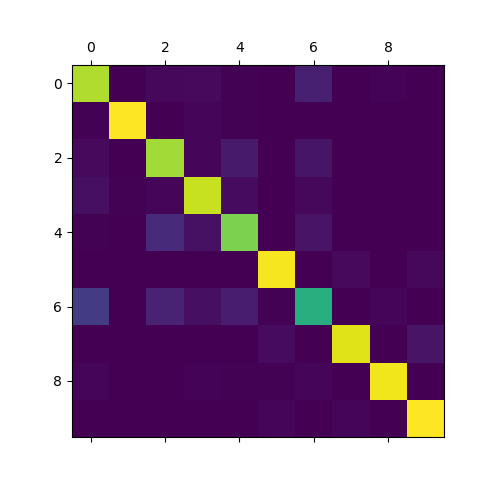学习多分类任务的混淆矩阵计算,共有两种方式:
one VS restone VS oneone VS rest 指定其中一个类别为正样本,将其他类别统统归类为负样本,然后进行混淆矩阵的计算
python sklearn提供了实现函数:sklearn.metrics.multilabel_confusion_matrix
1 def multilabel_confusion_matrix(y_true, y_pred, sample_weight =None, labels =None, samplewise =False ):
y_true:一维数组(仅输出正样本标签)或者多维矩阵(n_samples, n_outputs)y_pred:和y_true的格式一样labels:列表形式,指定正样本的顺序,否则函数将按排序顺序进行计算该函数计算基于每个类别的混淆矩阵,输出大小为(n_outputs, 2, 2),每个混淆矩阵的排列如下:
示例 对3类任务进行计算,输入标签如下:
1 ['cat ', 'ant ', 'cat ', 'cat ', 'ant ', 'bird ']
预测标签如下:
1 ['ant ', 'ant ', 'cat ', 'cat ', 'ant ', 'cat ']
计算每类的混淆矩阵,并指定计算顺序:
1 res = multilabel_confusion_matrix(y_true , y_pred , labels =["ant" , "bird" , "cat" ])
输出大小为(3, 2, 2)
1 2 3 4 5 6 7 8 [[[3 1 ] [0 2 ]] [[5 0 ] [1 0 ]] [[2 1 ] [1 2 ]]]
one VS one 在多分类任务中,还可以对每两个类别进行混淆矩阵的计算
python sklearn提供了实现函数:sklearn.metrics.confusion_matrix
1 def confusion_matrix(y_true , y_pred , labels =None, sample_weight =None) :
y_true:一维数组,指定正样本y_pred:一维数组,输出预测标签labels:指定正样本顺序函数返回一个(n_classes, n_classes)大小的混淆矩阵
示例 如果是二分类,其混淆矩阵排列为:
1 2 3 4 5 6 7 from sklearn.metrics import confusion_matrixif __name__ == '__main__' : tn, fp, fn , tp = confusion_matrix ([0 , 1 , 0 , 1 ], [1 , 1 , 1 , 0 ] ).ravel ( print (tn, fp, fn, tp ) # 输出 0 2 1 1
如果是多分类,其输出如下:
1 2 3 4 5 6 7 8 9 10 11 from sklearn.metrics import confusion_matrix if __name__ == '__main__' : y_true = ["cat" , "ant" , "cat" , "cat" , "ant" , "bird" ] y_pred = ["ant" , "ant" , "cat" , "cat" , "ant" , "cat" ] res = confusion_matrix(y_true, y_pred, labels=["ant" , "bird" , "cat" ]) print(res) # 输出 [[2 0 0 ] [0 0 1 ] [1 0 2 ]]
点\((i,i)\) 的值表示第\(i\) 类正确分类的数目 点\((i,j)\) 的值表示第\(i\) 类错误分类为\(j\) 类的数目 利用混淆矩阵查看错误分类 利用one vs one的方式计算多分类任务,能够理清具体的错误分类场景
数据集 参考Fashion-MNIST数据集解析
分类器 参考神经网络分类器
实现 1 2 3 4 5 6 7 8 9 10 11 12 13 14 15 16 17 18 19 20 21 22 23 24 25 26 27 28 29 30 31 32 33 34 35 36 37 38 39 40 41 42 43 44 45 46 "" " @author: zj @file: confusion-matrix.py @time: 2020-01-11 " "" from nn_classifier import NN from mnist_reader import load_mnist import numpy as npimport cv2from sklearn.metrics import confusion_matrix import matplotlib.pyplot as pltdef load_data(): path = "/home/zj/data/fashion-mnist/fashion-mnist/data/fashion/" train_images, train_labels = load_mnist(path, kind='train') test_images, test_labels = load_mnist(path, kind='t10k') return train_images, train_labels, test_images, test_labels if __name__ == '__main__': train_images, train_labels, test_images, test_labels = load_data() print(train_images.shape) print(train_labels.shape) x_train = train_images.astype(np.float64) x_test = test_images.astype(np.float64) mu = np.mean(x_train, axis=0) var = np.var(x_train, axis=0) eps = 1 e-8 x_train = (x_train - mu) / np.sqrt(np.maximum(var, eps)) x_test = (x_test - mu) / np.sqrt(np.maximum(var, eps)) classifier = NN([100 , 20 ], input_dim=28 * 28 , num_classes=10) classifier.train(x_train, train_labels, verbose=True) y_pred = classifier.predict(x_test) cm = confusion_matrix(test_labels, y_pred) print(cm) plt.matshow(cm) plt.show()
使用神经网络分类Fashion-MNIST,结果如下:
1 2 3 4 5 6 7 8 9 10 [[852 1 21 25 4 0 86 0 11 0] [ 7 967 3 16 5 0 1 0 1 0] [ 25 1 833 12 70 1 55 0 3 0] [ 38 5 14 888 30 2 20 0 3 0] [ 6 1 118 44 776 1 52 0 2 0] [ 0 0 0 0 1 955 0 23 2 19] [167 1 93 38 75 4 608 0 14 0] [ 0 0 0 0 0 28 0 921 0 51] [ 12 2 2 8 5 7 12 3 948 1] [ 0 0 1 0 0 14 1 16 0 968]]
从混淆矩阵中可以发现,标签0(就是T恤)最容易错误分类为标签6(就是衬衫);标签4(就是外套)最容易错误分类为标签2(就是套衫)
相关阅读 